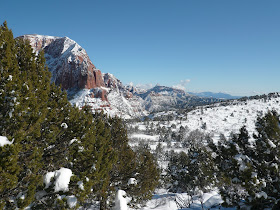 Being prepared in the wilderness is something that comes up frequently, whether it's posted on a trail head sign, being touted by forest rangers, or on the news when Search and Rescue had to pull someone off the mountain. Being prepared when hiking, camping, or doing other activities in the back country is not only a safety issue, but it also determines how the experience unfolds.
Being prepared in the wilderness is something that comes up frequently, whether it's posted on a trail head sign, being touted by forest rangers, or on the news when Search and Rescue had to pull someone off the mountain. Being prepared when hiking, camping, or doing other activities in the back country is not only a safety issue, but it also determines how the experience unfolds.A few weeks ago Jason, Mark (Chair of the USEE Programs Advisory Council), and I went down to Cedar City to do some outreach and for a Focus Group meeting we had in the area. Our meeting got out early and we had some extra time, so we decided that it would be great to do a little exploration in Color Country. Little did we know, we were (or at least especially I was) extremely unprepared. We had plenty of water and warm clothes, but in Cedar City it was a beautifully sunny day. There sky was free of clouds and the weather was the warmest I've felt since September.
We decided to try Kolob Canyons. The scenery is picturesque and classically Southern Utah. What we didn't anticipate, however, was the amount of snow there would be on the trails. Cedar City was so gorgeously warm, with no snow to be found, but as we ascended the road to the trail head, the snow kept getting deeper. Mark was smart enough to bring along some gaiters to cover his shoes and pants and had a fine time. Jason had some boots that went up pretty high on his ankles, and seemed to do okay in the deep snow. I, on the other hand, had my hiking boots (which are really more like shoes rather than boots) and not-warm-enough socks. I am also considerably shorter than Mark and Jason.
The snow was 3 feet or more deep. There had been a snowshoer on the trail recently before us, so we opted to follow in his tracks. The scenery was beautiful. There's nothing quite like snow gracing the steep walls of the red rock canyons. I had a hard time following the guys as the snow was from my knees to almost my hips every step of the way. We trudged along, laughing at our unpreparedness, telling stories of similar times when we'd been unprepared, and listening to Mark tell us of his encounters with mountain lions. Inevitably, my shoe got stuck deep in the snow. I stood there on one foot bending, flailing, and reaching into the hole where my shoe was lodged, my face mashed against the melting snow as I stretched down, all the while the snow packing into my empty boot. My socks, shoes, and pants were soaked and we were all tired from wading through the crunchy, sinking snow. We decided to head back. I gather that the whole excursion was barely longer than a mile, if even that.
The canyon was breathtaking, and the event itself was even fun, but mostly the whole situation was quite comical. What's the lesson I learned that day? Just because it's warm in the valley and Zions National Park is in the "desert" doesn't mean that it will be snow-free and dry. A little preparation and planning would have changed the whole experience. Snowshoes, anyone?



No comments:
Post a Comment